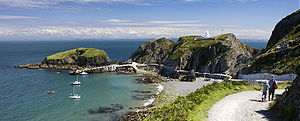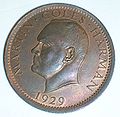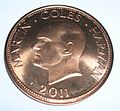- Coins of Lundy
-
 The harbour and jetty at Lundy
The harbour and jetty at Lundy
The coins of Lundy are two unofficial issues of currency from the island of Lundy, in the Bristol Channel off the west coast of England. In 1969 Jack Haywood, a British millionaire, purchased the island for £150,000 and gave it to the British people[1].
Contents
The coin issue of 1929
The first issue was issued in 1929 by the self-declared 'King of Lundy', Martin Coles Harman, who was an English businessman, born 1885, Steyning, Sussex, who bought Lundy in 1925. There were two coins - the Half Puffin and the One Puffin[2], which were rated at the same nominal value as the British Halfpenny and Penny. The obverse of the coins depict a portrait facing left with 'MARTIN.COLES.HARMAN'. The edges of the coins are lettered with the inscription 'LUNDY LIGHTS AND LEADS', a reference to the island's two lighthouses. The reverse of the Half Puffin coin depicts a puffin's head. The reverse of the One Puffin coin depicts a puffin facing left on a rocky ledge. The unfussy and strong design of the coins is regarded as more than competent with significant modernist touches which foresee the high 1930s design school. The currency was called the puffin because the islanders had a long history of bartering puffin feathers for food and other commodities. The coins were made of bronze, and landed Harman in trouble with the British authorities in 1930 for unauthorised minting of money.[3][4][5]
Visitors from the island could exchange any remaining 'puffins' at the banks in Bideford, who then returned the Lundy coins to the island (Coin News 1999). The coins were struck in Birmingham by Ralph Heaton's Mint, Birmingham Ltd. The currency saw real, if limited use. Martin Coles Harman died in 1954.
50,000 bronze tokens about the size of a penny were minted by Ralph Heaton & Sons, Birmingham in 1929, together with a similar number of articles about the size of a half-penny. The price was 50/9 per 1000 for the larger and 26/6 for the smaller, and there was a £100 fee for preparing the design and sinking the dies.[5]
Bronze pattern coins of the 1929 issue exist with a thicker flange and the lack of an edge inscription. The details on the obverse and reverse also differ slightly. The coins remain highly collectible to this day.
The court cases
Harman had sent specimen coins to the Royal Mint and had been thanked for them, although they had warned him about Section 5 of the Coinage Act 1870. Harman replied that Lundy was a little Kingdom in the British Empire, but out of England. He recognised King George V as the head of state, however he was adamant that Lundy was a self-governing dominion within the British Empire. This led to a visit from the Devon Constabulary and a Supt. Bolt and other officers reported seeing the coins (tokens) in use at the Marisco Tavern, mixed with standard British Imperial coinage. Harman lost his case at the Petty Sessions in Bideford and appealed to the High Court of Justice where he also lost and was fined £5, with fifteen guineas (£15 15s) costs.[3][6].
Some details of the court cases
Sir Hugh N. Grenville Stucley was the presiding magistrate at the Petty Sessional Division court which tried the case of Supt. Bolt on behalf of the Director of Public Prosecutions v. Martin Coles Harman, charged with on the 5th day of March, 1930, in the Island of Lundy in the County of Devon, did unlawfully as a token for money issue a piece of metal to the value of one half-penny, contrary to Section 5 of the Coinage Act of 1870.
The appeal trial was held on January 13, 1931, at the King's Bench Division of the High Court of Justice, in London, and, it was hoped at the time, would settle the status of Lundy once and for all. It didn't--but it did show how utterly confused the situation was. In his defense, Mr. Harman said he had every right to mint money, for Lundy, in his words, was "a vest-pocket-size, self-governing dominion," out of the realm for every practical purpose. The Lundy residents, he pointed out, never had paid any taxes to England and were liable to customs when they went there, for Lundy itself was a free port. The Attorney General, who was prosecuting Mr. Harman, said that Lundy was surely a Utopia but that its inhabitants would be just as happy if the face of King George V, rather than of Mr. Harman, were depicted on the place's currency. (Mr. Harman's face was on the front of the coins, and that of a puffin on the back. There were two denominations, a one-puffin coin and a half-puffin coin, neatly convertible to a penny and a ha'penny at the legal rate of exchange.[7]
Time (America) report for Monday, January 20th, 1930
Coins denominated the puffin and half-puffin—respectively worth a British penny and half-penny—have just gone into circulation among the 40 dwellers on Lundy Island in the Bristol Channel, also called "Puffin Island." Both half and whole puffins bear the likeness of Martin Coles Harman, Esq., London merchant, who bought Puffin Island in 1925 and plays at being its king. On the "tails" side of a puffin is the head of a puffin (sea bird with a parrotlike beak and white cheeks). Puffin Islanders also have puffin stamps. Red and green, in puffin and half-puffin denominations, each having a handsome steel engraving of a puffin perched on a rock.
The 1965 issue of Lundy coinage
In 1965, a second issue of coins, made by John Pinches, was carried out. These were a commemorative issue to commemorate the 40th anniversary of Harman's purchase of Lundy. The coins are of the same design as the 1929 issue coins, but have plain edges. They were struck in Proof sets, in bronze, nickel-brass, and gold. They were issued in a special case of which at least two varieties exist. 3000 of the base metal sets were issued and 25 of the gold sets. Apart from the sets, 25 each of the proof gold denominations were also issued for presentation purposes.[1][5] It has been reported that Lundy puffin forgeries may exist. This seems unlikely and it may be that confusion with the 'pattern coins' or between the 1929 and 1965 issues has resulted in an erroneous interpretation.
1929 and 1965 coins
2011 coins
A set of five unauthorised 'fantasy' Lundy Puffin coins were put on sale in 2011. These five coins are dated 2011 and are in the Puffin denominations, ranging from half, one, two, four to six. Only half and one Puffin coins have been issued in the past. They carry the same edge inscription as the original coins and the same portrait of Martin Coles Harman. The half and one Puffin are in a copper appearance, the two and four are in a brass appearance and the six Puffins is silver coloured. The half and one are unchanged, whilst the two has two puffins flying, the four a Lundy lighthouse, and the six has Tresco Castle on the reverse.[8] The six puffin coin has a reeded edge and is crown size. The quailty of these coins is surprisingly high.
Thomas Bushell and coins of the Civil War
Another possible coinage connection exists through the activities of one Thomas Bushell, friend of Francis Bacon, a strong supporter of the Royalist cause during the First English Civil War and an expert on mining and coining. It has been argued that during his stay on Lundy he produced coinage for King Charles I, however definitive proof has not been found and it remains speculation. He held Lundy for the King and this was the last part of the king's lands to capitulate to the victorious Parliamentary forces after a siege lasting a year.[3][9]
See also
- Moreton House
- Token coins
References
- ^ a b Bruce, Colin R (1988). Unusual World Coins (2nd ed.). Krause Publications. p. 150. ISBN 0-87341-116-1.
- ^ Purvey, Frank (1963). Collecting Coins. W. & G. Foyle. p. 71.
- ^ a b c Boundy, Wyndham S (1961). Bushell and Harman of Lundy. Bideford.
- ^ De Agostini (2000). Coins of the World. pp. 327–328.
- ^ a b c Krause, Chester L. and Clifford Mishler (1979). Standard Catalog of World Coins: 1980 Edition. Colin R. Bruce II (senior editor) (6th ed. ed.). Krause Publications. pp. p. 1204. ISBN 0873410505.
- ^ Matthews, David (May 1999). "Eccentric Issues". Coin News: p.41. ISSN 0958-1391.
- ^ Sack, John (2000). Report From Practically Nowhere. ISBN 0-595-08918-6.
- ^ World of Coins Retrieved : 2011-09-29
- ^ Seaby, Peter (1985). The Story of British Coinage. Seaby. p. 111. ISBN 0-900-652-74-8.
Bibliography
- Becker, Thomas W. (1961). The puffin coins of Lundy.
External links
- Coincraft.com
- A History of Lundy Island
- Details of Pinches, the manufacturer of the 1965 Lundy Coins
- Time article and archives
- Reports of forgeries of Lundy Coins
Wikimedia Commons has media related to: Categories:- Coins of the United Kingdom
- Numismatics
- Exonumia
Wikimedia Foundation. 2010.





